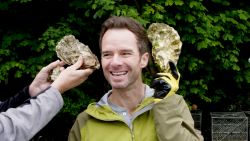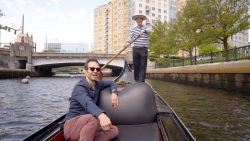










Knoxville residents have a slogan for their city: Keep Knoxville scruffy.
It’s a tongue-in-cheek response to a slight from a Wall Street Journal reporter writing about Knoxville’s ultimately successful bid to host the 1982 World’s Fair. When he referred to this locale as “a scruffy little city,” residents decided to wear the insult as a badge of honor – and still do.
“We don’t need to be fancy and polished,” goes the thinking. “We’re proud of our patina. It’s so much more interesting.”
Not to mention friendly. “I came here for college in 1987 and never left,” says Tanya Kanczuzewski, a locally based marketing director. “This is a strong community town. Anywhere you go, people are happy to stop and have a conversation, point you in the right direction, or give you tidbits of advice. Other than the traffic on I-40, it doesn’t feel overwhelming here like bigger cities.”
more america's best TOWNS to visit 2024
Knoxville’s tallest building is 27 stories, yet it has a distinctive skyline thanks to the Sunsphere, a golden glass ball 75 feet in diameter sitting atop a 198-foot steel tower that was built for the aforementioned World’s Fair. The glass contains 24-karat gold dust, making the sphere glow when the sun hits it. The observation deck inside provides a 365-degree view, including the Great Smoky Mountains to the south. A welcome center is currently under construction on the level below the observation deck.
Another huge ball of note is the 30-foot tall, 10-ton basketball (the world’s largest) outside the Women’s Basketball Hall of Fame. This is the only facility of its kind devoted to all levels of women’s basketball, and it’s here for good reason.
Knoxville is home to the wildly popular University of Tennessee Lady Vols basketball team and was also home to legendary coach Pat Summitt, whose 1,098 career wins were the most in Division I college basketball history – for men’s or women’s teams – at her retirement in 2012.
The city also goes crazy for the university’s football team, which plays in the perpetually sold-out 102,000-seat Neyland Stadium. On fall game days, everything is awash in orange and white, the university’s colors. (Knoxville has no pro sports teams, but the AA baseball team — the Knoxville Smokies, a minor league affiliate of the Chicago Cubs — will get a boost when they open their 2025 season in a new, multipurpose stadium on the edge of downtown).
The university is central to the city’s history. James White, the founder of Knoxville, set up a fort and some cabins in 1786 in the Great Valley at the headwaters of the Tennessee River, on lands that were hunting grounds of the Cherokee Indians. The settlement was known as Knoxville by 1791, and by 1794, the town was home to Blount College. Today, it’s known as the University of Tennessee.

‘Best sound’ around
Market Square, Knoxville’s most popular gathering place, is a pedestrian plaza in the heart of downtown that offers eclectic boutiques, restaurants and rooftop bars. There’s a farmer’s market here from late spring to early fall, free concerts (including jazz performed by the Knoxville Jazz Orchestra) in summer and an ice-skating rink in winter.
The Gay Street historic district just a block away is also a hot spot. This 10-block stretch includes art galleries, shops, bars, hotels and restaurants housed in buildings that date as far back as the late 1800s. A popular First Friday art walk is held here monthly, with galleries and other businesses offering free drinks and snacks.
“First Friday is a blast,” says Colby McLemore, a professional photographer who has a studio downtown. “I love the diversity of the art and the relaxed and inviting vibe. It’s one of my favorite things about Knoxville.”
Gay Street is also home to three historic theaters, all gems.
You can’t miss the Tennessee Theatre, with its six-story vertical sign that lights up at night. This grande dame was built in 1928 and underwent a $25 million renovation in 2005. Its original decor includes crystal chandeliers and Italian terrazzo flooring. While it’s home to the city’s symphony orchestra and opera company, you can also see other musical and theatrical performances and even vintage films here.
Knoxville, TN: No. 9 on America's Best Towns to Visit list
The Bijou Theatre sits two blocks down Gay Street. Its opening show in 1909 starred George M. Cohan. Performances today include all manner of concerts in a fairly intimate 700-seat theater known for its stellar acoustics.
“It has the best sound of any venue I’ve ever been in, including those in Nashville and Atlanta,” says Jody Collins, host of the podcast “Ramblin’ Man,” who often interviews entertainers, such as local and touring musicians who come through town. “There isn’t a bad seat in the house.”
The Regal Riviera Theatre, a modern movie theater with an old-fashioned-looking facade, occupies the same site as an Art Deco movie house also called the Riviera Theater that was built in 1920 but torn down in 1988. It’s one block in the opposite direction from the Tennessee Theatre.
Tucked into the northeast corner of downtown is Old City, more or less the Greenwich Village of Knoxville. This offbeat urban neighborhood has the city’s most concentrated collection of restored Victorian buildings and is filled with funky coffee shops, diverse dining spots, art galleries, beer joints and spiffy cocktail bars (including Brother Wolf, which enjoys a national reputation).
‘Best soft-serve in the Southeast’
You may not expect to find world-class dining in a small Southern city, but it’s here. Joseph Lenn, owner of J.C. Holdway, was the first chef in the state to win a James Beard Award. He cooks his inventive fare in a wood-fire oven.

“I think some restaurants here hold up against a Pete Wells New York Times review,” notes native New Yorker and longtime Knoxville resident Steven Friedlander, an editor and writer. He names Osteria Stella (Italian) and Kefi (Greek), both in Old City, and Vida (pan-Latin) on Gay Street as his favorite examples.
“Then skip dessert at the fancy restaurants and go to Cruze Farm on Gay Street for ice cream,” he adds. “It’s a local dairy that sells some of the best soft-serve in the Southeast.”
The craft beer craze is alive and well here. The Knoxville Area Brewers Association promotes an Ale Trail highlighting 27 breweries. Clusters of them exist in the Central Street/Broadway area north of downtown and on Sevier Avenue, just over the bridge from downtown in South Knoxville (christened SoKno by the neighborhood’s young adult population). More are sprinkled about town and in the suburbs.
“Xül Beer Company in the Old City is my personal favorite,” Kanczuzewski says, “but my secret pleasure is Abridged, a brewpub in a converted mechanic’s garage in Bearden,” a suburb close to downtown. “It’s my go-to place for the best burger in town.”
Before they’re famous
It’s already known as the “Cradle of Country Music” thanks to its role in developing the careers of stars like Dolly Parton, Chet Atkins and Roy Acuff, but Knoxville is fast gaining a more modern reputation as a great place for live music. This is due in large part to the growing popularity of a music festival founded in 2009 known as Big Ears—music industry slang for an especially acute and perceptive listener, according to festival founder Ashley Capps.
Big Ears, named “music festival of the year” by Spin in 2023, is undeniably Knoxville’s biggest music coup. People come from all over the United States and even overseas to attend. (Last year, 70% of the 30,500 attendees were out-of-towners.) The festival offers diverse genres in multiple downtown venues, from big theaters to hole-in-the-wall bars. Cellist Yo-Yo Ma has shown up, as has Led Zeppelin bassist John Paul Jones. This year, multiple-Grammy winner Andre 3000 (half of the hip hop duo Outkast) gave a flute concert at St. John’s Cathedral.
“We are not the next big thing, we are our own thing,” explains Collins about Knoxville’s music scene in general. In addition to attracting major acts, Collins notes, “This is also a great place to see underground bands before they break.”
He saw Green Day in 1992 (pre “Dookie”) at a local pub, and he saw Lake Street Dive (before the band was big) with only seven other people in the audience. He also saw heavy metal band System of a Down before they racked up so many Grammys.
KNOXVILLE ESSENTIALS
- EAT: At Osteria Stella, a hip Italian eatery from Knoxville dining royalty
- DRINK: At Brother Wolf, a sophisticated Italian-themed aperitivo bar
- STAY: At The Tennessean, a luxury hotel in an ultra-modern setting
- PLAY: In Knoxville’s Urban Wilderness for outdoor adventures in the city’s green heart
“My dad and his uncles saw Alabama when they were a bar band on The Strip,” he adds, using a locals’ term for Cumberland Avenue, a street that runs from downtown through the adjacent campus of the University of Tennessee.
Of the handful of bars he frequents for live music, the Pilot Light in Old City is his favorite. “The capacity is only 75,” he says, “so you can often experience something that may never be replicated.”
Another intimate music experience is the Blue Plate Special, a free live concert presented at noon at the visitor’s center on Gay Street and broadcast on WDVX. (Concert-goers are even invited to bring their lunch.) All types of local and internationally famous artists appear here.
“Amy Ray of the Indigo Girls will be passing through town and play at the Blue Plate Special,” Collins notes.
10 minutes from a trailhead
While the city is about an hour from Great Smoky Mountains National Park (the most visited US national park and home to beautiful luminous evening displays by fireflies), you don’t have to go that far to commune with nature.
Knoxville’s 1,500-acre Urban Wilderness includes five city parks, four Civil War sites, wildlife areas, a nature preserve, several waterways and more. Its 60-plus miles (100 kilometers) of hiking and mountain biking trails and greenways connect downtown with the surrounding area.

“In 10 minutes from downtown, you can be at a trailhead,” says Jeff Shmerler, a retired tech industry engineer who is active in the local mountain biking club. No need to bring your own equipment – some hotels rent or lend bikes to guests, and numerous rental shops can set you up with bikes and watercraft.
“You can go canoeing, hiking and biking all in the same day,” Shmerler notes.
The nonprofit Ijams Nature Center is a core part of the Urban Wilderness, with more than 300 acres of forests, meadows, wetlands and creeks. It’s also home to an independently operated adventure park with zip lines, swinging bridges, balance challenges and more.
Shmerler sums it up well: “This is a cool place to be.”
Next town: Duluth, Minnesota is No. 10
How outdoor activities and a creative spirit make it cooler by the lake.
Katy Koontz is an award-winning freelance writer who has lived in Knoxville, Tennessee, for the past 35 years.










